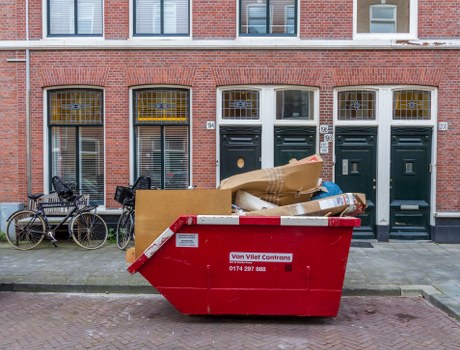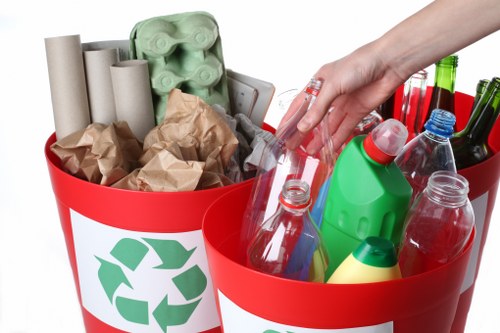Builders Waste Clearance in Barkingside: Efficient and Eco-Friendly Solutions

Builders waste clearance is a crucial aspect of any construction or renovation project in Barkingside. Proper disposal and management of construction debris not only ensure compliance with local regulations but also contribute to a cleaner and safer environment. Whether you're a homeowner undertaking a renovation or a contractor handling large-scale projects, understanding the best practices for waste clearance is essential.
In Barkingside, the demand for reliable builders waste clearance services has been on the rise. With the area experiencing significant development, the need for efficient waste management solutions has become paramount. This article delves into the various aspects of builders waste clearance in Barkingside, providing valuable insights and practical tips to help you navigate the process seamlessly.
From understanding the types of construction waste to selecting the right clearance service, we'll cover everything you need to know to ensure your project runs smoothly. Our goal is to equip you with the knowledge to make informed decisions that benefit both your project and the community.

The Importance of Proper Builders Waste Clearance
Proper builders waste clearance is not just about tidying up a construction site. It plays a significant role in environmental conservation, public health, and the overall efficiency of construction projects. Here's why it matters:
- Environmental Protection: Proper disposal of construction waste helps reduce pollution and minimizes the impact on local ecosystems.
- Health and Safety: Clearing waste promptly prevents accidents and reduces the risk of health hazards associated with debris.
- Regulatory Compliance: Adhering to local waste management regulations avoids legal penalties and ensures smooth project progression.
- Resource Recovery: Recycling and reusing materials can lead to cost savings and promote sustainable building practices.
By prioritizing waste clearance, builders and contractors contribute to a more sustainable and orderly construction environment in Barkingside.
Failure to manage construction waste effectively can lead to numerous issues, including increased project costs, delays, and damage to the community's aesthetic appeal. Therefore, integrating waste management strategies into your construction plan is indispensable.

Types of Builders Waste
Construction projects generate various types of waste, each requiring different handling and disposal methods. Understanding these categories is essential for effective waste clearance:
- Debris: General construction debris includes materials like broken concrete, wood scraps, and miscellaneous construction remnants.
- Hazardous Waste: This category comprises materials that pose environmental or health risks, such as asbestos, lead-containing paints, and solvents.
- Recyclable Materials: Items like metals, glass, and certain plastics can be recycled and repurposed, reducing the overall waste footprint.
- Organic Waste: In some construction projects, especially those involving landscaping, organic waste like plant matter and soil may be generated.
Proper categorization and segregation of these waste types are crucial for efficient disposal and recycling efforts.
Different types of waste require specific disposal methods. For instance, hazardous waste must be handled by specialized services to prevent environmental contamination, while recyclable materials can be sorted and processed accordingly.

Steps for Effective Builders Waste Clearance
1. Assessing the Waste
Begin by evaluating the volume and types of waste your project will generate. This assessment helps in planning the appropriate clearance strategy, determining the necessary resources, and estimating costs.
Consider factors such as the size of the project, the materials used, and the duration of the construction. Accurate assessment ensures that you have a clear understanding of the waste management needs.
Accurate waste assessment also aids in compliance with local regulations and facilitates the selection of suitable disposal or recycling options.
Key Considerations:
- Project Scope
- Material Types
- Volume of Waste
- Local Regulations
2. Choosing the Right Disposal Methods
Selecting appropriate disposal methods is vital for effective waste clearance. Depending on the waste type, you may need different strategies:
- Landfill Disposal: Suitable for non-recyclable and non-hazardous waste.
- Recycling: Appropriate for materials like metals, glass, and certain plastics.
- Hazardous Waste Treatment: Requires specialized handling and disposal to prevent environmental harm.
- Composting: Ideal for organic waste generated from landscaping or certain construction activities.
By matching disposal methods to waste types, you enhance the efficiency of the clearance process and minimize environmental impact.
It's also beneficial to work with waste clearance professionals who can guide you in selecting the most sustainable and cost-effective disposal options.

3. Hiring Professional Waste Clearance Services
Engaging a reputable builders waste clearance company in Barkingside ensures that the process is handled efficiently and in compliance with local regulations. Professional services offer several advantages:
- Expertise: Professionals are knowledgeable about different waste types and the best disposal practices.
- Efficiency: They have the resources and equipment to handle large volumes of waste promptly.
- Compliance: Ensure that all disposal methods adhere to local laws and environmental standards.
- Cost-Effective: Professional services can help minimize costs through optimized waste management strategies.
When selecting a waste clearance provider, consider their experience, reputation, and the range of services they offer to meet your project's specific needs.
Additionally, inquire about their recycling and sustainability practices to ensure that your waste clearance aligns with environmental conservation goals.
4. Implementing Waste Management Plans
Developing a comprehensive waste management plan is essential for systematic builders waste clearance. This plan should outline the procedures for waste collection, segregation, storage, and disposal.
Effective planning helps in minimizing waste generation, promoting recycling, and ensuring that waste is handled safely and efficiently throughout the project lifecycle.
Components of a Waste Management Plan:
- Waste Identification and Segregation
- Collection and Transportation Methods
- Storage Solutions on-site
- Disposal and Recycling Procedures
- Monitoring and Reporting Systems

Environmental Benefits of Proper Waste Clearance
Adhering to effective builders waste clearance practices provides significant environmental benefits. These include:
- Reduced Landfill Usage: By recycling and reusing materials, the reliance on landfills decreases, prolonging their lifespan and reducing environmental strain.
- Resource Conservation: Recycling materials conserves natural resources, ensuring their availability for future generations.
- Pollution Prevention: Proper disposal methods prevent the release of harmful substances into the environment, safeguarding air, water, and soil quality.
- Energy Savings: Recycling often requires less energy compared to producing new materials from scratch.
These benefits not only contribute to a healthier environment but also enhance the sustainability of construction projects in Barkingside.
Moreover, embracing eco-friendly waste clearance practices can improve your company's reputation and appeal to environmentally conscious clients.
Incorporating sustainable waste management into your projects demonstrates a commitment to environmental stewardship and can differentiate your services in a competitive market.

Legal Requirements for Builders Waste Clearance in Barkingside
Compliance with local regulations is essential for builders waste clearance in Barkingside. Understanding these legal requirements helps avoid penalties and ensures that your waste management practices are environmentally sound.
Key legal aspects include:
- Waste Disposal Permits: Certain types of waste may require permits for disposal or transportation.
- Recycling Mandates: Regulations may mandate the recycling of specific materials like metals, glass, and plastics.
- Hazardous Waste Handling: Strict guidelines govern the handling, storage, and disposal of hazardous waste to prevent environmental contamination.
- Reporting and Documentation: Proper documentation of waste disposal processes may be required for regulatory compliance.
Staying informed about the latest regulations and collaborating with waste clearance professionals can help maintain compliance and promote responsible waste management practices.
Regular audits and inspections can also ensure that your waste management strategies align with legal standards and best practices.
Consequences of Non-Compliance:
- Fines and Penalties
- Project Delays
- Legal Repercussions
- Reputational Damage

Choosing the Right Builders Waste Clearance Service in Barkingside
Selecting the appropriate waste clearance service is pivotal for the success of your construction project. Here are some factors to consider:
- Experience: Look for companies with a proven track record in handling builders waste clearance.
- Service Range: Ensure the service provider offers comprehensive solutions, including waste collection, recycling, and disposal.
- Environmental Practices: Choose companies that prioritize recycling and sustainable waste management.
- Cost-Effectiveness: Compare pricing structures to find a service that fits your budget without compromising on quality.
- Customer Reviews: Positive feedback from previous clients can indicate reliability and efficiency.
By carefully evaluating these factors, you can partner with a waste clearance service that aligns with your project's needs and sustainability goals.
Additionally, consider the company's responsiveness and willingness to accommodate your specific requirements to ensure a smooth waste clearance process.
Moreover, inquire about their scheduling flexibility to coordinate waste clearance with your project's timeline effectively.

Benefits of Hiring Local Waste Clearance Services
Opting for local waste clearance services in Barkingside offers several advantages:
- Quick Response Time: Local providers can address your waste clearance needs promptly, minimizing project delays.
- Community Knowledge: They are familiar with local regulations and disposal sites, ensuring compliant waste management.
- Support Local Economy: Hiring local businesses contributes to the economic growth of the Barkingside community.
- Personalized Services: Local companies often offer more tailored and attentive customer service.
Supporting local waste clearance services fosters community relationships and promotes sustainable development within Barkingside.
Furthermore, local companies may offer competitive pricing and customized solutions that larger, national providers cannot provide.

Cost Factors in Builders Waste Clearance
Understanding the cost factors involved in builders waste clearance helps you budget effectively and avoid unexpected expenses. Key cost elements include:
- Volume of Waste: Larger volumes typically incur higher disposal fees.
- Type of Waste: Hazardous or specialized waste may require additional handling, increasing costs.
- Service Frequency: Regular waste clearance schedules may offer cost savings compared to ad-hoc services.
- Transportation Fees: Distance from the disposal site can affect transportation costs.
- Recycling Fees: Processing recyclable materials may involve separate charges or discounts.
By identifying these factors, you can plan your waste clearance budget more accurately and explore ways to optimize costs without compromising on service quality.
Additionally, negotiating with service providers for bulk deals or long-term contracts can lead to significant savings.
Moreover, investing in effective waste management practices can reduce overall project costs by minimizing waste generation and promoting material reuse.
Tips to Reduce Builders Waste Clearance Costs
Implementing strategic measures can help lower waste clearance expenses:
- Waste Minimization: Plan projects meticulously to minimize waste generation through efficient use of materials.
- Recycling: Maximize recycling efforts to reduce the volume of waste sent to landfills.
- Efficient Segregation: Properly segregate waste to streamline the clearance process and avoid additional handling fees.
- Reuse Materials: Identify opportunities to reuse materials on-site, decreasing the need for disposal.
- Select Cost-Effective Services: Compare different service providers to find the most economical options that meet your requirements.

Best Practices for Builders Waste Clearance
Adopting best practices in waste clearance ensures efficiency, compliance, and sustainability. Here are some recommended strategies:
- Early Planning: Integrate waste management into the initial project plan to anticipate and address waste clearance needs proactively.
- Training Staff: Educate workers on proper waste segregation and handling to enhance overall waste management.
- Regular Monitoring: Continuously monitor waste generation and clearance processes to identify areas for improvement.
- Utilize Technology: Implement software or tools to track waste management activities, ensuring efficiency and accountability.
- Engage Stakeholders: Collaborate with all parties involved in the project to foster a collective commitment to effective waste clearance.
These practices contribute to a streamlined waste management process, reducing delays and enhancing project outcomes.
Moreover, maintaining clear communication channels with your waste clearance service provider can facilitate smooth operations and prompt issue resolution.
Incorporating these best practices not only optimizes waste clearance but also promotes a culture of responsibility and sustainability within your project team.
Implementing Sustainable Waste Management
Sustainability in waste management involves adopting practices that minimize environmental impact and promote resource conservation. Key aspects include:
- Maximizing Recycling: Prioritize the recycling of materials to reduce landfill usage and conserve natural resources.
- Using Eco-Friendly Disposal Methods: Opt for disposal techniques that have minimal environmental impact.
- Promoting Reuse: Identify opportunities to reuse materials within the project or for future projects.
- Reducing Waste Generation: Implement strategies to cut down on waste production from the outset.
By focusing on sustainable waste management, builders contribute to environmental preservation and foster long-term ecological balance.
Additionally, sustainable practices can enhance your project's reputation, attracting clients who value environmental responsibility.

Conclusion: Streamlining Builders Waste Clearance in Barkingside
Effective builders waste clearance is integral to the success of construction projects in Barkingside. By understanding the types of waste, choosing appropriate disposal methods, and partnering with professional services, you can ensure a smooth and compliant waste management process.
Embracing sustainable practices not only benefits the environment but also enhances the efficiency and cost-effectiveness of your projects. Proper waste clearance contributes to safer construction sites, regulatory compliance, and the overall well-being of the Barkingside community.
Don't let waste management challenges hinder your project’s progress. Contact us today to learn how our expert builders waste clearance services can support your construction needs in Barkingside.
Take the proactive step towards a cleaner, safer, and more sustainable construction environment by booking your service now. Let us handle your waste clearance, so you can focus on building the future.
